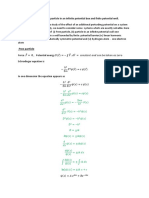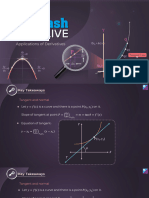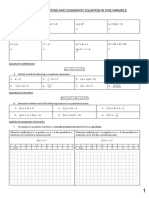Differentiation Notes
Uploaded by
dheekshaDifferentiation Notes
Uploaded by
dheeksha𝑦 = 𝑓(𝑥) → 𝑦 = 𝑓'(𝑥) Concept
Stationary point of Gradient of stationary Work systematically from left to
𝑦 = 𝑓(𝑥) becomes point is zero right
𝑥-intercept of 𝑦 = 𝑓'(𝑥) 1. Label all the 𝑥 related
values, such as new 𝑥
Point of inflexion of A point of inflexion is
𝑦 = 𝑓(𝑥) becomes the where the gradient of a -intercepts, vertical
stationary point of curve transits from asymptotes
𝑦 = 𝑓'(𝑥) increasing to decreasing 2. Label all the 𝑦 related
or vice-versa values by finding all the
horizontal asymptotes, 𝑦
Vertical asymptote of Gradient becomes
𝑦 = 𝑓(𝑥) remains undefined at vertical -intercepts and coordinates
unchanged in 𝑦 = 𝑓'(𝑥) asymptote of turning points
Horizontal asymptote of Gradient tends to zero at
𝑦 = 𝑓(𝑥) becomes the horizontal asymptote
horizontal asymptote
𝑦 = 0 in 𝑦 = 𝑓'(𝑥)
𝑓'(𝑥) > 0, then the graph Gradient is positive
of 𝑦 = 𝑓'(𝑥) lies above
the 𝑥-axis
𝑓'(𝑥) < 0, then the graph Gradient is negative
of 𝑦 = 𝑓'(𝑥) lies below
the 𝑥-axis
Implicit differentiation
𝑑 𝑛 𝑑 𝑛 𝑑𝑦 𝑛−1 𝑑𝑦
𝑑𝑥
(𝑦 ) = 𝑑𝑦
(𝑦 ) 𝑑𝑥
= 𝑛𝑦 𝑑𝑥
, where n is a rational number
𝑑 𝑑 𝑑𝑦 𝑑𝑦
𝑑𝑥
(𝑓(𝑦)) = 𝑑𝑦
(𝑓(𝑦)) 𝑑𝑥
= 𝑓'(𝑦) 𝑑𝑥
Strategy Example
Implicit differentiation to Qns: Find the equation of the tangent to the curve
𝑑𝑦 3 2 2
find 𝑑𝑥 is useful if 𝑦 cannot 𝑦 − 2𝑥𝑦 + 3𝑥 − 3 = 0 at the point (2, 3)
be expressed in terms of Solution: Differentiate implicitly w.r.t. 𝑥
2
the independent variable 𝑥 3𝑦
2 𝑑𝑦
− 4𝑥𝑦
𝑑𝑦 2
− 2𝑦 + 6𝑥 = 0 ⇒
𝑑𝑦
=
2𝑦 −6𝑥
𝑑𝑥 𝑑𝑥 𝑑𝑥 2
explicitly 2
3𝑦 −4𝑥𝑦
𝑑𝑦 2(3) −6(2)
When 𝑥 = 2, 𝑦 = 3, 𝑑𝑥
= 2 =2
3(3) −4(2)(3)
Equation of tangent is 𝑦 − 3 = 2(𝑥 − 2) ⇒ 𝑦 = 2𝑥 − 1
Logarithmic differentiation Qns: Differentiate 𝑥
𝑠𝑖𝑛𝑥
with respect to 𝑥
is useful for expressions of 𝑠𝑖𝑛𝑥
𝑣 Solution: Let 𝑦 = 𝑥
the form 𝑢 , where both 𝑢 Taking ln on both sides, 𝑙𝑛𝑦 = (𝑠𝑖𝑛𝑥)𝑙𝑛𝑥
and 𝑣 are non-constant Differentiate implicitly w.r.t. 𝑥
expressions of 𝑥 and/or 𝑦 1 𝑑𝑦 1
𝑦 𝑑𝑥
= (𝑠𝑖𝑛𝑥)( 𝑥 ) + (𝑙𝑛𝑥)𝑐𝑜𝑠𝑥
𝑑𝑦 1 𝑠𝑖𝑛𝑥 1
𝑑𝑥
= 𝑦( 𝑥 𝑠𝑖𝑛𝑥 + (𝑙𝑛𝑥)𝑐𝑜𝑠𝑥) = 𝑥 (𝑥 𝑠𝑖𝑛𝑥 + (𝑙𝑛𝑥)𝑐𝑜𝑠𝑥)
Maxima & Minima
Steps Example Pointers
1.Identify the constants A closed rectangular cuboid of Do not directly
and variables in the dimensions 𝑥 cm by 𝑥 cm by ℎ cm differentiate the
question has a fixed surface. Use expression while it is still
differentiation to show that the in terms of two variables
2.Express the quantity to maximum volume of the cuboid is
be maximised or 𝑆
3/2
3 Be smart in choice of
equal to 𝑐𝑚
minimised in terms of two 6 6 variable to eliminate
suitable variables Constant: Surface area of cuboid,
𝑆 𝑐𝑚
2 Even though it may be
3.Use given information in Variables: Sides of cuboid, clear there is only one
the question to express 𝑥 𝑐𝑚 & ℎ 𝑐𝑚 choice of value for 𝑥, a
one of the two suitable Let the volume of the cuboid be V. derivative test must be
variables in terms of the 2 conducted to check the
other 𝑉 = 𝑥 ℎ (1) nature of the stationary
2
𝑆 = 2𝑥 + 4𝑥ℎ value
4.Re-express the quantity 𝑆−2𝑥
2
𝑆 𝑥
ℎ= = − (2)
to be maximised or 4𝑥 4𝑥 2 The substitution of the 𝑥
minimised in terms of one Sub (2) into (1) -value into the 2nd
3
of the two variables only 2
𝑉 = 𝑥 ℎ = 𝑥 ( 4𝑥 −
2 𝑆 𝑥
)=
𝑆𝑥
−
𝑥 derivative must be
2 4 2
2 explicitly shown and the
𝑑𝑉 𝑆 3𝑥
5.Differentiate the quantity 𝑑𝑥
= 4
− 2 corresponding value
to be maximised or 𝑑𝑉 evaluated. The same
minimised in terms of the When = 0,
𝑑𝑥 principle applies for the
2
remaining variable 𝑆
−
3𝑥
=0 1st derivative test
4 2
2
6.Equate the derivative to 3𝑥
=
𝑆
2 4
zero and solve for the
2 𝑆 𝑆
variable 𝑥 = 6
⇒𝑥 = 6
(𝑥 > 0)
2
𝑑𝑉 𝑆
7.Use the first or second 2 =− 3𝑥 So when 𝑥 = 6
𝑑𝑥
derivative test to check for 2
𝑑𝑉 𝑆
the nature of the 2 =− 3 <0
𝑑𝑥 6
stationary value
𝑆
V is maximum when 𝑥 = 6
8.Solve for the required
Maximum value of
quantity
𝑆 𝑆 1 𝑆 3
𝑉= 4
( 6
)− 2
( 6
)
3/2 3/2
1 1 𝑆 𝑆
= (4 − 12
) = (shown)
6 6 6
You might also like
- 96605_Calculus Exams (model answer with steps)No ratings yet96605_Calculus Exams (model answer with steps)69 pages
- 1600.io Essential SAT Math Study Notes - V1.3No ratings yet1600.io Essential SAT Math Study Notes - V1.346 pages
- 1600.io Essential SAT Math Study Notes_V1.0 (1)No ratings yet1600.io Essential SAT Math Study Notes_V1.0 (1)45 pages
- Points of Intersection - Merry ChrismayantiNo ratings yetPoints of Intersection - Merry Chrismayanti10 pages
- Simple Equation 3 2 1 4 6 3 4 6 4 3 2 3 3 2 Multiply To Get Rid of Brackets, 'S To One Side, Numbers To The OtherNo ratings yetSimple Equation 3 2 1 4 6 3 4 6 4 3 2 3 3 2 Multiply To Get Rid of Brackets, 'S To One Side, Numbers To The Other2 pages
- Get Calculus single variable Bretscher free all chaptersNo ratings yetGet Calculus single variable Bretscher free all chapters55 pages
- CAPE Integrated Mathematics Stationary Points100% (2)CAPE Integrated Mathematics Stationary Points14 pages
- Rules_for_Quadratic_Epressions_and_EquationsNo ratings yetRules_for_Quadratic_Epressions_and_Equations1 page
- Calculus: Single and Multivariable 7th Edition by Deborah Hughes Hallett, William McCallum, Andrew Gleason, Eric Connally, Daniel Flath ISBN 1119444195 9781119444190instant download100% (2)Calculus: Single and Multivariable 7th Edition by Deborah Hughes Hallett, William McCallum, Andrew Gleason, Eric Connally, Daniel Flath ISBN 1119444195 9781119444190instant download83 pages



























































